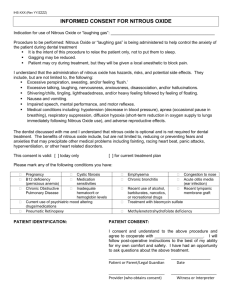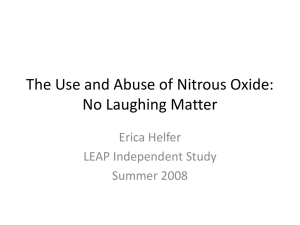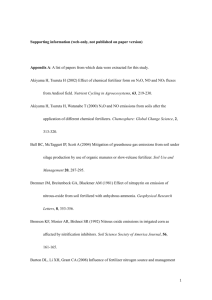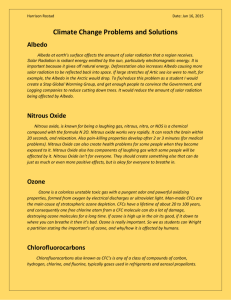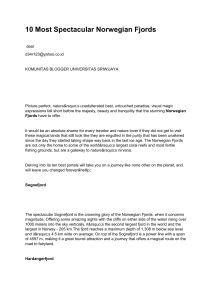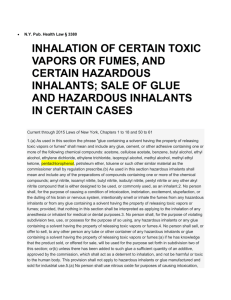Workplan
advertisement
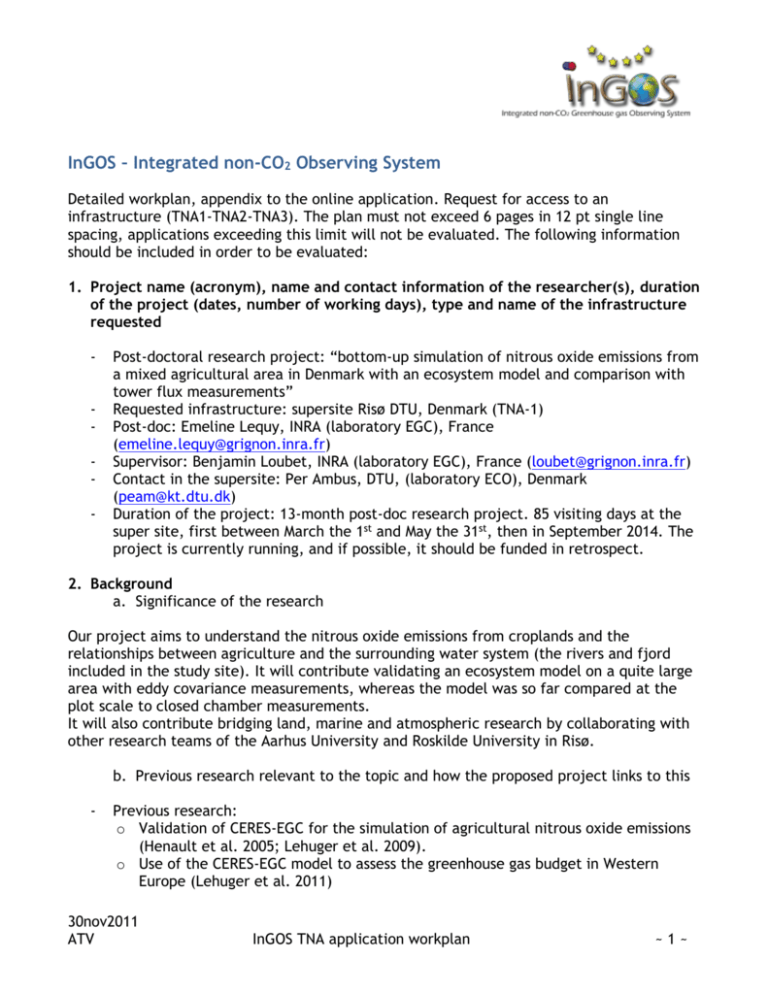
InGOS – Integrated non-CO2 Observing System Detailed workplan, appendix to the online application. Request for access to an infrastructure (TNA1-TNA2-TNA3). The plan must not exceed 6 pages in 12 pt single line spacing, applications exceeding this limit will not be evaluated. The following information should be included in order to be evaluated: 1. Project name (acronym), name and contact information of the researcher(s), duration of the project (dates, number of working days), type and name of the infrastructure requested - Post-doctoral research project: “bottom-up simulation of nitrous oxide emissions from a mixed agricultural area in Denmark with an ecosystem model and comparison with tower flux measurements” Requested infrastructure: supersite Risø DTU, Denmark (TNA-1) Post-doc: Emeline Lequy, INRA (laboratory EGC), France (emeline.lequy@grignon.inra.fr) Supervisor: Benjamin Loubet, INRA (laboratory EGC), France (loubet@grignon.inra.fr) Contact in the supersite: Per Ambus, DTU, (laboratory ECO), Denmark (peam@kt.dtu.dk) Duration of the project: 13-month post-doc research project. 85 visiting days at the super site, first between March the 1st and May the 31st, then in September 2014. The project is currently running, and if possible, it should be funded in retrospect. 2. Background a. Significance of the research Our project aims to understand the nitrous oxide emissions from croplands and the relationships between agriculture and the surrounding water system (the rivers and fjord included in the study site). It will contribute validating an ecosystem model on a quite large area with eddy covariance measurements, whereas the model was so far compared at the plot scale to closed chamber measurements. It will also contribute bridging land, marine and atmospheric research by collaborating with other research teams of the Aarhus University and Roskilde University in Risø. b. Previous research relevant to the topic and how the proposed project links to this - Previous research: o Validation of CERES-EGC for the simulation of agricultural nitrous oxide emissions (Henault et al. 2005; Lehuger et al. 2009). o Use of the CERES-EGC model to assess the greenhouse gas budget in Western Europe (Lehuger et al. 2011) 30nov2011 ATV InGOS TNA application workplan ~1~ o Use of the CERES-EGC model all over France and comparison with closed chamber measurements and ORCHIDEE model simulation in the IMAGINE project - Links with the proposed project o Quantify nitrous oxide emission on a larger scale (footprint at least 5km around the tall mast) using eddy covariance measurements o Opportunity to validate the CERES model and compare its daily simulated values with ongoing measurements at the RISØ supersite o COCOA European project, which study nitrogen retention in different learning sites, including Roskilde fjord next to the Risø supersite, with measurements of N2O from the fjord sediments o EcoCLIM Danish project, which focuses on C-GHGs at a larger scale than our project, and also links marine, terrestrial and atmospheric research, and aims to link C-GHGs with the N cycle c. Links with current research of the applicant The applicant leads this 1-year post-doc project. 3. Objectives a. Hypothesis and research objectives Hypotheses: - 3 sources of emissions: agriculture, fjord catchment and urban waste management - footprint of the tall mast following a circadian cycle (5-km radius in the daytime, 20km radius in the night time) Objectives: - Simulate the N2O emissions from the crops, and compare to measurements at the INGOS crop site. - Estimate the emissions from Roskilde fjord - Apply the IPCC emission factors in the study site - GIS: aggregate simulated data by taking into account the footprint function of the mast - Compare the estimated and the measured values from the mast b. Connection with the InGOS objectives and the ‘fitness’ of the use of the requested infrastructure to the objectives - Quantify nitrous oxide emissions Use the Risø supersite’s tall mast to obtain ongoing N2O fluxes from a 2000-ha area Understand the eddy covariance measurements using simulated data and footprint function 30nov2011 ATV InGOS TNA application workplan ~2~ 4. Methods and materials (legal and ethical issues) a. Research method, explaining how to reach the objective - Use of ecosystem models CERES-EGC for culture crops and COUP for the willow energy plantation Measurements and analyses of N-concentrations in the fjord water and calculate the N2O emission flux Eddy covariance measurement of N2O fluxes on the tall mast b. Research materials, instrumentation - Tall mast and eddy covariance setup Material to sample the fjord water Laboratory analyses for nitrous oxide, nitrate, nitrite and ammonium concentrations in the fjord water CERES-EGC and COUP models (Gabrielle et al. 1995, 2006; Jansson 2012) c. Governance procedures, safety precautions, permit requirements and procedures - Eddy covariance measurements: they are automatic on the mast and must be analyzed by a researcher. Fjord measurements: three measurement campaigns will be carried on in the fjord with a boat offered by researchers of the Aarhus University, with whom we collaborate. One campaign will take place in the beginning of May, one in summer and one in autumn, in order to study the seasonal variations of N 2O emissions. Regarding the measurement campaigns, the water samples will be taken at 15 points that cover the area of the fjord which is in the footprint of the tall mast. Three samples will be taken at each point. One will be analyzed for its N2O concentration, one for its inorganic nutrient concentration (N, P, and Si), and one for salinity. 5. Implementaton: timetable, budget, distribution of work a. Timetable for the research including personnel efforts, favorably table wise - Research work with a defined deadline: Deadlines Work package Task Human resources April 1st week Modelling Get the data to feed the model post-doc April 2nd week Modelling First runs of the model post-doc May 1st week Measurement First campaign in Roskilde fjord May 1st week Measurement First measurements from the tall mast post-doc + Aarhus University researchers researcher at ECO May 4th week Modelling Comparison data/measurements for May 30nov2011 ATV InGOS TNA application workplan post-doc ~3~ June 2nd week Modelling Apply the IPCC factors in the study site post-doc June 4th week Modelling post-doc During July Measurement Apply the footprint function to the available simulated data Second campaign in Roskilde fjord During September Measurement Third campaign in Roskilde fjord - post-doc + Aarhus University researchers post-doc + Aarhus University researchers Research work with a defined deadline: Work package Task Human resources Modelling Refine the input files and the footprint function post-doc Measurement Ongoing nitrous oxide fluxes from the tall mast to manage and analyze Analyses of the fjord water and nitrous oxide emissions from the fjord after the field measurement campaigns researcher at ECO Measurement laboratory technician b. Total budget for travel and logistical support as requested Working days Travel budget Total Quantity 85 1 Maximum per diem amount (€) 50 500 Total (€) 4,250 500 4,750 c. Plan for specific logistical needs like visa, import/export licenses etc. Nothing specific to mention. 6. Expected results and possible risks a. Expected scientific impact of the research - Better quantify the nitrous oxide emissions with ongoing eddy covariance tower measurements and not only with closed chambers. Contribute to improve the complementarity between simulation and measurement values Contribute to our current knowledge of footprints Collaboration between agriculture, forest, atmospheric and marine research Contribute to validate IPCC emission factors for agriculture b. Applicability and feasibility of the research results The supersite is in function and eddy covariance measurements of nitrous oxide are soon available. The data to feed the model are being collected. 30nov2011 ATV InGOS TNA application workplan ~4~ The footprint of the tall mast has already been studied by micrometeorology researchers from the University of Helsinki and should be applied to the measured and simulated data using GIS c. Publication plan - One main article dealing with the comparisons between the measured and the modelled data One article dealing with the feasibility to adapt the crop ecosystem CERES-EGC to willow energy plantation One article dealing with the N2O emissions from the fjord with the Aarhus University d. Data access plan The CERES-EGC simulations will be in open access after being publication. CERES-EGC is open source and downloadable at http://wwwegc.grignon.inra.fr/applis/ceres_mais/ceres.html 7. Key literature a. List of references used in the working plan Gabrielle B, Laville P, Hénault C, Nicoullaud B, Germon JC. Simulation of Nitrous Oxide Emissions from Wheat-cropped Soils using CERES. Nutr Cycl Agroecosyst. 2006 Feb 1;74(2):133–46. Gabrielle B, Menasseri S, Houot S. Analysis and Field Evaluation of the Ceres Models Water Balance Component. Soil Science Society of America Journal. 1995;59(5):1403. Henault C, Bizouard F, Laville P, Gabrielle B, Nicoullaud B, Germon JC, et al. Predicting in situ soil N(2)O emission using NOE algorithm and soil database. Glob Change Biol. 2005 Jan;11(1):115–27. Jansson P-E. Coupmodel: Model Use, Calibration, and Validation. Trans ASABE. 2012 Aug;55(4):1335–44. Lehuger S, Gabrielle B, Oijen M van, Makowski D, Germon J-C, Morvan T, et al. Bayesian calibration of the nitrous oxide emission module of an agro-ecosystem model. Agriculture, Ecosystems & Environment. 2009 Oct;133(3–4):208–22. 30nov2011 ATV InGOS TNA application workplan ~5~
